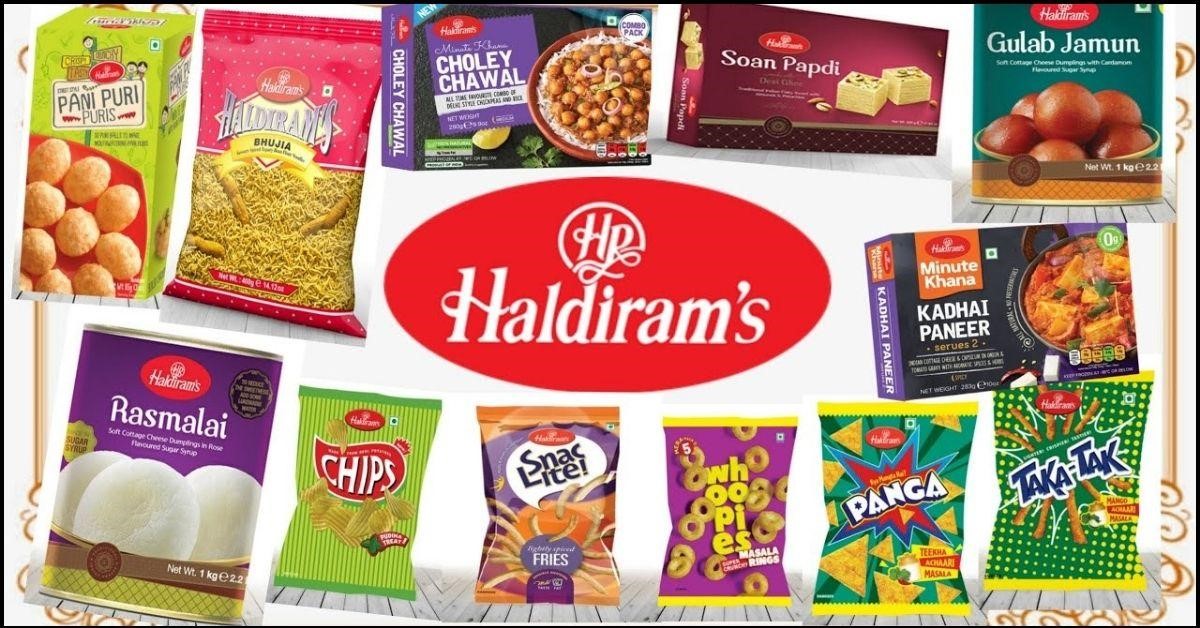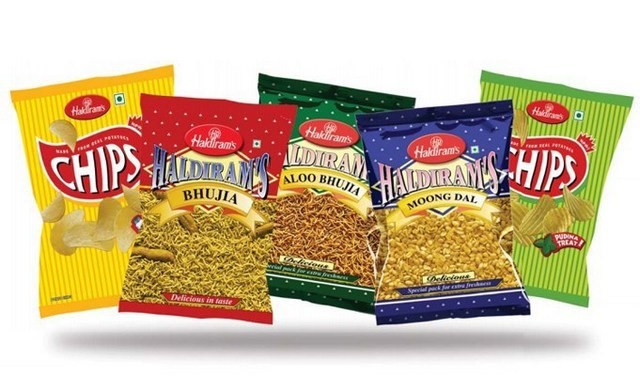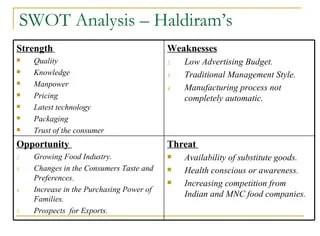
Haldiram's Case Study
Introduction:
Haldiram’s is a major Indian corporation known for its sweets, snacks, and restaurants. It is based in Noida and operates manufacturing facilities in various cities including Nagpur, New Delhi, Gurgaon, Hooghly, Rudrapur, and Noida. The company also runs its own chain of retail stores and restaurants across several cities such as Pune, Nagpur, Raipur, Kolkata, Noida, and Delhi.
History
Haldiram’s originated in 1937 as a small sweets and snacks shop in Bikaner, Rajasthan, established by Ganga Bishan Agarwal, affectionately known as Haldiram Ji.
To facilitate growth, the company established its first manufacturing plant in Kolkata, formerly Calcutta. Subsequently, in 1970, a larger plant was set up in Jaipur. The early 1990s saw the inauguration of another manufacturing facility in New Delhi.
In 2003, Haldiram’s embarked on developing convenience foods for consumer markets.
By 2014, Haldiram’s had earned recognition as the 55th most trusted brand in India, as per the Brand Trust Report. Its rapid expansion led to it becoming India’s largest snack company in 2017, surpassing both domestic and international competitors.
In January 2024, Haldiram initiated talks to acquire a majority stake in Prataap Snacks, valued at $350 million, aiming to strengthen its presence in the potato chip market. The negotiations included discussions regarding a potential premium valuation and acquiring at least a 51% stake.
Haldiram’s products are now available in over 80 countries, and the company is actively expanding its franchise network.
About Haldiram’s
- Type: Confectionery and snack food company
- Industry: Food and beverage
- Founded: 1937
- Founders: Ganga Bishan Agarwal
- Headquarters: Noida, India
- Area served: India, USA, UK, Middle East, South East Asia, and other countries
- Current CEO: Aditya Agarwal
- Number of employees: Over 20,000
- Major products: Namkeens, sweets, snacks, and beverages
The Marketing Mix
The Marketing mix of Haldirams delves into the 4Ps: Product, Price, Place, and Promotion strategies employed by the company. Haldiram’s, an Indian private enterprise, operates within the food and beverage sector, crafting delectable, hygienic, and authentic Indian culinary delights. Established in 1937 by Gangabhisan Aggarwal, its headquarters are based in Nagpur, India. Haldiram’s has positioned its products to cater to a wide demographic, targeting individuals of all ages and socio-economic backgrounds, offering something suitable for everyone’s palate and preferences.
Haldirams Product Strategy
Haldiram’s is renowned across India for its delectable range of sweets and snacks. The brand offers nearly one hundred authentic food items catering to various niche markets. Its diverse array of sweet shops includes:
- Namkeens such as Sev, Mathri, Panchratan Mixture, Navratan Mixture, Samosa, Gol Kachori, Murukku, Lite Chiwda, Bhel, Aloo Lachha, Dry Fruit Mix, Chana Choor, and Salted Kaju.
- Refreshing drinks like Orange Squash, Pineapple Squash, and Rose Sharbat.
- Indulgent sweets like Mango Bite, Peanut Chikki, Rajbhog, Gulab Jamun, Soan Papdi, Kaju Katli, and Badam Barfi.
- Assorted biscuits including Kaju Butter, Pista Badam, and Kaju Nankhatai.
- Dairy delights such as Rassagolla, Sandesh, and Chamcham.
- Tempting Kesar sticks kulfi and Ice creams.
- Pappad.
- Ready-to-eat items like Punjabi Choley, Pav Bhaji, and Dal Makhni.
In 2023, Haldiram’s product mix includes:
Namkeens (Savory Snacks): Aloo Bhujia, Moong Dal, Chana Chur, Bhel Puri, Navratan Mix, Masala Chana
Sweets: Rasgulla, Gulab Jamun, Soan Papdi, Kaju Katli, Rajbhog, Peda, Jalebi
Snack Mixes: Bombay Mix, Diet Chivda, Khatta Meetha Mix, Pudina Sev, Kashmiri Mixture
Ready-to-Eat Products: Ready-to-Eat Curries, Biryani, Paneer Dishes, Parathas, Samosas, Spring Rolls
Bakery Items: Cookies, Biscuits, Soan Cake
Beverages: Fruit Juices, Soft Drinks
Frozen Foods: Frozen Snacks, Frozen Desserts

Haldirams Place Strategy
Haldiram’s, a renowned brand known for its quality and flavor, originated from a humble shop in Bikaner and has since expanded its presence not only within India but also internationally. It exports its products to various countries including Thailand, Japan, New Zealand, Australia, UAE, Canada, UK, and Sri Lanka.
Within India, it operates through a vast network of retail outlets, making its products easily accessible in numerous food stores, confectionary shops, bakeries, convenience stores, local markets, discount stores, supermarkets, and hypermarkets. Its initial manufacturing facility was established in Kolkata, followed by plants in Nagpur, Bikaner, and New Delhi.
With manufacturing facilities and outlets in key cities like Kolkata, Mumbai, New Delhi, Nagpur, and Bangalore, Haldiram’s also maintains an online presence through its official website and partnerships with various e-commerce platforms. Through a robust distribution network, products are distributed to retailers and consumer markets by C&F agents and distributors, ensuring wide availability both domestically and internationally.
Here are five important points regarding Haldiram’s distribution strategy:
- Broad Retail Presence: Haldiram’s has a widespread retail network, comprising its own branded outlets, franchise locations, and partnerships with supermarkets and convenience stores. This extensive presence ensures that customers can easily find Haldiram’s products in various places.
- Online Retail and E-commerce: The company has established a strong online presence through its official website and collaborations with e-commerce platforms. This approach enables customers to conveniently purchase Haldiram’s products online and have them delivered to their homes, enhancing accessibility.
- Global Expansion: Haldiram’s has expanded its market beyond India and into international territories. They distribute their products through diverse channels in countries around the world, making Indian snacks and sweets available to consumers globally.
- Effective Supply Chain Management: The company prioritises efficient supply chain management to ensure prompt product delivery to its retail outlets. This involves well-coordinated distribution networks, inventory control, and transportation logistics.
- Product Innovation and Localization: Haldiram’s tailors its product offerings to align with the preferences of specific regions and consumer demographics. This approach allows them to effectively penetrate diverse markets within India and abroad by offering customised products suited to local tastes and preferences.
Haldirams Pricing Strategy
The company recognized the price sensitivity of Indian consumers and opted for a competitive pricing strategy, keeping its prices lower than its competitors. This approach aimed to make its products affordable and within reach of customers, aligning with their budget constraints.
Haldiram’s introduced smaller packaging options to encourage more frequent purchases, resulting in higher sales volumes and increased overall revenue.
Key aspects of Haldiram’s pricing strategy include:
Value-Based Pricing: Haldiram’s focuses on providing value to its customers by pricing its products based on the perceived value they offer in terms of taste, quality, and brand reputation.
Premium Pricing for Quality: Known for its high-quality snacks and sweets, Haldiram’s adopts a premium pricing strategy to reflect its superior product standards and establish itself as a trusted and premium brand.
Competitive Pricing: In a competitive market, Haldiram’s closely monitors its rivals’ pricing strategies to ensure its offerings remain competitive. It seeks to differentiate itself through product quality, variety, and brand image.
Dynamic Pricing: During special events or promotions, Haldiram’s may employ dynamic pricing tactics like discounts, bundled offers, or limited-time deals to attract and retain customers, boosting sales during peak periods.
International Pricing Adaptation: In global markets, Haldiram’s adjusts its pricing strategy to accommodate local market conditions, currency fluctuations, and competitive dynamics. This adaptability enables the brand to stay competitive while catering to regional preferences and economic factors.
Haldiram’s promotional strategy revolves around:
Festive and Seasonal Campaigns: During festivals and special occasions, Haldiram’s launches tailored marketing initiatives that resonate with cultural sentiments, aiming to drive sales during peak seasons.
Digital Marketing and Social Media: Utilising social media platforms and digital advertising, Haldiram’s interacts with customers online, building brand recognition and highlighting its product range to a wider audience.
Product Sampling and In-Store Promotions: To encourage trial and purchase, Haldiram’s organises product sampling events and promotions within stores, fostering customer engagement and loyalty through firsthand experience with its products.
Haldiram’s quest to become a global brand name
Pankaj believes that Indian fast food hasn’t gained global popularity due to the complexity of its preparation and the lack of investment in packaging for extending shelf life. For instance, dishes like Rajkachauri require numerous fresh ingredients and specific spices, some of which have short shelf lives. In contrast, Western fast food like burgers and pizzas can be frozen and easily transported globally, thanks to advanced packaging and supply chain technology.
Haldiram’s can position itself as an Indian fast food brand rather than a Western one, avoiding direct competition with franchises like Pizza Hut or McDonald’s. This opens up a significant market opportunity for Haldiram’s to establish itself as a global brand. The company receives inquiries from businesses worldwide interested in franchising Haldiram’s restaurants, indicating strong international demand for its products.
Challenges faced by Haldiram’s
One of the significant challenges faced by Haldiram’s in the food industry is the preference of Indian customers for fresh food over packaged items, except for namkeens. Customers often demand freshly packed sweets, even if the packaging indicates a shelf life of several days. This demand for freshness poses a challenge for Haldiram’s, prompting them to focus on enhancing their packaging methods. Despite lacking food technologists, Haldiram’s has established a fully equipped laboratory with chemists to address this challenge and develop improved packaging solutions internally.
Competitors
Entrepreneurs from South India typically focus on offering authentic South Indian cuisine when expanding into the North, whereas Haldiram’s has a broader positioning. While customers seeking specific South Indian meals may choose a South Indian restaurant, Haldiram’s caters to families where each member desires a different type of cuisine, making it their preferred choice. In the namkeen and snacks segment, Haldiram’s faces competition mainly from Lehar, Pepsi, and Frito Lay. However, the branded namkeen market in India represents only a small portion of total namkeen sales, with many local manufacturers offering loose namkeen at lower prices. Although Haldiram’s maintains quality leadership, competing on cost is challenging due to factors like supply chain and distribution costs, especially in smaller cities and villages where customers prioritize affordability over quality. Namkeen accounts for over 90% of Haldiram’s total turnover, with the fast food segment comprising only about 10%. While Pepsi may have an advantage in snack categories like potato chips, Haldiram’s strategy is not to directly compete but to focus on creating its own market niche. Instead of large-scale advertising, Haldiram’s relies on its distributor network for low-key promotion, aiming to gradually capture market share through a guerrilla warfare approach, avoiding head-on competition with larger competitors like Pepsi.
Franchise opportunities
As stated earlier, Haldiram’s are developing their own internal systems. Until and unless, they are strong in-house, they would not like to expand. Unlike their competitors Haldiram’s don’t want to dish out a lot of franchisees and expand very fast. They would rather like to grow steadily but at the same time have everything in control. They are definitely thinking of giving their franchisees. They are not franchising across the board for all htier products, they would rather limit their variety. So, they will be focusing only on their core products like Indian chat, papri chat, golgappas, Indian snacks like chole-bhature, pav-bhaji, tikkis. They want to give out franchisees for that along with the sweets. They want to promote both of these products together in a branded format. Haldiram’s don’t want to go far from Delhi so in order to maintain control and face the initial problems more effectively. Maybe they can even take it in another way that they buy a place, they invest everything and they manage it in the way of a franchisee. Like today, they manage each and every outlet personally. They go visit that place but that model they can take in the form of franchisee, how to deal with the franchisee so that they can learn from it and at the same time, they don’t affect their brand name also because that will be done everything in house. So, at any time they can change the model. There is a vast scope in Delhi. They don’t have any outlets in west and east Delhi. They are looking to start in Delhi to see how things turn up, customers reaction, turnover of the franchisee, costs etc.
The concept of frozen technology
Studies for frozen pizzas and burgers are common in the industry, unlike frozen samosas, due to the relatively low demand for the latter. In the United States, frozen samosas and parathas are readily available, thanks to established technology and infrastructure for frozen products. However, in India, the lack of a robust cold chain infrastructure and frozen refrigerators in shops hampers the adoption of frozen products. Despite this, certain Indian products like frozen samosas and tikkis show promise for leveraging frozen technology. Therefore, the export market becomes the primary target for such frozen products, as the Indian market requires time to adapt. Haldiram’s may face challenges in establishing its brand domestically, prompting foreign companies to consider Haldiram’s as a sourcing partner and use their brand for global sales. Haldiram’s is open to partnerships with international firms interested in purchasing frozen samosas for local markets, provided it is profitable. Currently, Haldiram’s is researching freezing technology, experimenting with frozen products to determine shelf life and taste compared to fresh ones. Initially, they plan to introduce frozen concepts in one of their outlets. Haldiram’s focus remains on food, as it is their core expertise, with no intention to diversify into unrelated sectors like television manufacturing, which faces intense competition and limited profit potential.
SWOT Analysis of Haldirams
Strengths in the SWOT analysis of Haldirams:
This analysis sheds light on the core strengths of Haldiram’s, showcasing its competitive advantages in the market. Strengths typically represent the fundamental expertise of the business.
- Brand Recognition: Haldiram enjoys significant brand awareness globally, positioning itself as an Indian brand with a wide international reach, consistently supplying products across borders.
- Diverse Product Line: The brand boasts an extensive and varied product line, offering customers numerous options such as namkeens, papads, chips, cookies, sweets, dry fruits, and sherbets.
- Trusted Quality and Hygiene: Haldiram’s restaurants maintain high standards of cleanliness and hygiene, earning trust for the quality of their products.
- Eye-Catching Packaging: Haldiram’s products feature attractive packaging that catches the attention of customers in retail stores, even if not placed at eye level, contributing to increased sales.
- Efficient Supply Chain: Haldiram has developed a robust supply chain network, ensuring product availability at various points of sale, a crucial factor in driving sales.
- Competitive Pricing: The brand strategically prices its products to cater to middle and upper-income groups, offering different package variants priced according to quantity, making them accessible to a broad customer base.
- Flavorful Taste: Customers appreciate the distinctive taste of Haldiram’s products, establishing a niche in the market for its food offerings.
- Global Reach: Haldiram’s global presence enhances its brand reputation, signalling that its products are exported internationally, further solidifying its position in the market.
Weaknesses in the SWOT analysis of Haldirams :
This represents the areas of concern within the organisation, where there’s a lack of resources or expertise. It’s essential for businesses to address these areas to remain competitive. While every business may have some weaknesses, they shouldn’t be significant enough to jeopardise the company’s position in the market.
- Branding and Advertising: Haldiram’s marketing efforts are relatively limited, primarily focusing on Above-the-Line (ATL) activities. This approach puts the brand at a slight disadvantage compared to competitors who invest more heavily in marketing and advertising.
- Limited Presence in South India: Despite its global reach, Haldiram’s stores are primarily concentrated in northern India. As a result, the brand’s popularity is confined to this region, limiting its exposure to other parts of the country and potentially hindering its overall market penetration.
Opportunities in the SWOT analysis of Haldirams :
This enables businesses to explore new avenues for growth and leverage their existing skills and resources. It allows them to identify areas where they can expand their operations and attract a broader customer base.
- Market Expansion: Haldiram’s has the opportunity to further penetrate the Indian market beyond its current stronghold in northern India. This expansion can help broaden its customer base and increase brand recognition nationwide.
- Diversification into Hospitality: There’s potential for Haldiram’s to venture into the hospitality sector on a global scale. With a significant Indian diaspora worldwide, investing in hotels could capitalise on this market and expand the brand’s reach.
- Enhanced Marketing Efforts: Implementing aggressive advertising and branding strategies can boost Haldiram’s visibility and brand recall, helping to capture more market share and attract new customers.
- Health-Conscious Snacks: Introducing healthier snack options, such as low-fat, low-calorie baked snacks, can appeal to health-conscious consumers and tap into growing market trends for healthier eating choices.
- Innovation for Youth: Developing innovative snack offerings tailored to the preferences of younger consumers can help Haldiram’s stay relevant and capture a demographic that values novelty and variety in their food options.

Threats in the SWOT analysis of Haldirams :
This analysis sheds light on potential challenges that could impact the business in the near or distant future, necessitating preparedness to navigate these threats within the market landscape. The emergence of competitors or a rise in the number of players offering similar value propositions poses a direct threat to the business, leading to a decline in customer base and revenue.
- Shifting Consumer Preferences: There’s a growing inclination among Indian consumers towards Western tastes and perceptions that Indian snacks are unhealthy due to their oil content. This presents an ongoing challenge for Haldiram’s to attract and retain customers who may prefer alternatives perceived as healthier.
- Negative Brand Perception: The general perception of Indian snacks as unhealthy casts a shadow on Haldiram’s business, potentially tarnishing its reputation. Overcoming this negative perception becomes crucial for maintaining and strengthening the brand’s image in the market.
- Intensifying Competition: The competitive landscape is becoming increasingly crowded, with more brands vying for market share. This heightened competition poses challenges for Haldiram’s to differentiate itself and maintain its position in the market amidst increasing rivalry from other players.

VISION, MISSION & VALUES
VISION
- Sustain and Expand Business: Maintain a trajectory of consistent and sustainable growth both domestically in India and internationally, through organic expansion and strategic acquisitions.
- Enhance Market Leadership: Consolidate and strengthen market leadership in traditional Indian snacks and sweets while also striving to achieve leadership status in Western snack categories.
- Foster Innovation: Continuously innovate and develop new high-quality products to meet evolving consumer preferences, offering a diverse range of superior food items at competitive prices to delight customers.
MISSION
- Offer Authentic Vegetarian Products: Ensure the availability of genuine, delicious, and high-quality vegetarian food items crafted in accordance with international standards at affordable prices, both within India and overseas.
- Stay Competitive Through Innovation: Maintain a competitive edge over rivals by continually innovating products, embracing emerging technologies, and optimising production costs.
- Adhere to Legal and Environmental Standards: Uphold legal regulations and prioritise environmental responsibility in all business operations.
- Cultivate a Positive Workplace: Create a welcoming and supportive work environment that attracts top talent and provides employees with opportunities for growth and career advancement.
- Offer Growth Opportunities: Ensure that all stakeholders, including stockists, distributors, retailers, suppliers, etc., have opportunities for growth and development within the company’s ecosystem.
- Maintain Financial Stability: Strive to operate as a debt-free company whenever feasible to ensure financial stability and sustainability.
- Increase Shareholder Value: Enhance the net worth of shareholders by implementing strategies that maximise returns and drive long-term growth.
- Support Social Causes: Contribute to social causes and give back to society as part of the company’s corporate social responsibility initiatives.
VALUES
- Our primary focus is on providing nutritious, authentic, and flavorful foods. We are dedicated to maintaining high standards of quality and ensuring freshness in all our products. We understand the importance of consistently delivering food that our customers love, both locally and globally. Ultimately, the most meaningful recognition for us comes from the satisfaction and appreciation of our customers.
Conclusion
In summary, Haldiram’s journey from a small shop to a big brand shows how it adapted and grew in the food industry. Its success comes from offering a wide variety of tasty snacks and sweets that people love. Haldiram’s focus on quality and freshness has earned trust from customers all over the world. By expanding into new markets and constantly improving its products, Haldiram’s stays ahead of its competitors. Looking forward, Haldiram’s will keep growing and providing delicious, healthy food that people enjoy.







